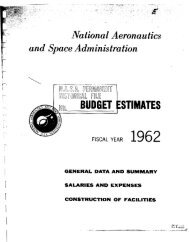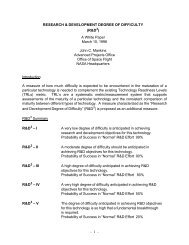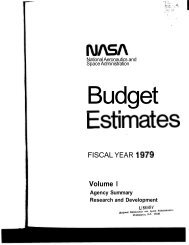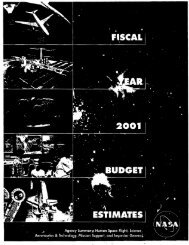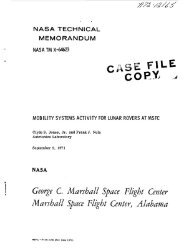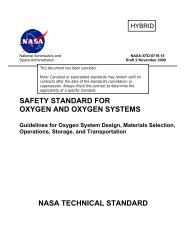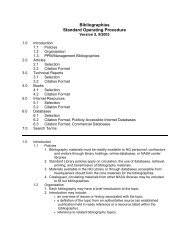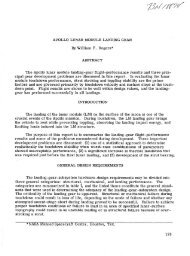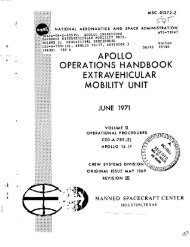crimping, interconnecting cables, harnesses, and wiring - NASA
crimping, interconnecting cables, harnesses, and wiring - NASA
crimping, interconnecting cables, harnesses, and wiring - NASA
Create successful ePaper yourself
Turn your PDF publications into a flip-book with our unique Google optimized e-Paper software.
Page 69 of 114<br />
<strong>NASA</strong>-STD-8739.4 with Change 6<br />
combinations not contained in Table 13-1, the tensile strength of the crimp connection shall be<br />
no less than 60 percent of the tensile strength of the wire (Requirement).<br />
13.7.5 Examination of Test Samples. Each individual test sample shall be inspected to the<br />
requirements of this document <strong>and</strong> the observations recorded <strong>and</strong> maintained (Requirement).<br />
Grounding Lead<br />
Wire Size<br />
Table 13-1. Pull Force 1<br />
Applied Force<br />
Minimum Newtons (Pounds)<br />
AWG 24 Copper 36 (8)<br />
AWG 22 Copper 57 (13)<br />
1/ For wire sizes not listed, the minimum applied force shall be 60 percent of the<br />
tensile strength of the wire being pulled.<br />
13.8 Inspection <strong>and</strong> Verification Testing<br />
Inspection <strong>and</strong> verification of assembled connectors shall include, but not be limited to, the<br />
following tests <strong>and</strong> inspections:<br />
13.8.1 Visual Examination. One hundred percent visual inspection shall be conducted for<br />
acceptable soldering, proper identification, <strong>and</strong> freedom from damage (Requirement).<br />
13.8.2 Contact Seating. Each contact in connectors utilizing retention clips or tines shall be<br />
push or pull tested 100 percent for seating (Requirement). The results shall be recorded <strong>and</strong> shall<br />
be limited to one push test per contact insertion (Requirement).<br />
a. Push Testing. In applications in which the engaging (mating) ends of the pins or socket<br />
contacts are accessible, contact retention testing to the requirements of Table 13-2 shall be<br />
performed (Requirement). Push testing shall utilize a tool that minimizes the possibility of<br />
accidental contact bending <strong>and</strong> applies a controlled, preset pressure to the contact before<br />
releasing the force (Requirement). A typical tool design is shown in Figure 13-1. Socket testing<br />
probes shall be undersized compared to mating-pin diameters <strong>and</strong> shall not cause a mating cycle<br />
to take place (Requirement).<br />
Contact sizes<br />
22, 22D <strong>and</strong><br />
22M<br />
Table 13-2. Contact Retention Test Forces<br />
Push Test Force<br />
(Newtons (Pounds)<br />
17.8 to 26.7<br />
(4 to 6)<br />
20 22.2 to 31.1<br />
(5 to 7)<br />
16 35.6 to 44.5<br />
(8 to 10)<br />
12 44.5 to 53.4<br />
(10 to 12)<br />
Pull Test Force Newtons<br />
(Pounds) 1/, 2/<br />
13.3 to 22.2<br />
(3 to 5)<br />
13.3 to 22.2<br />
(3 to 5)<br />
17.8 to 31.1<br />
(4 to 7)<br />
17.8 to 31.1<br />
(4 to 7)



